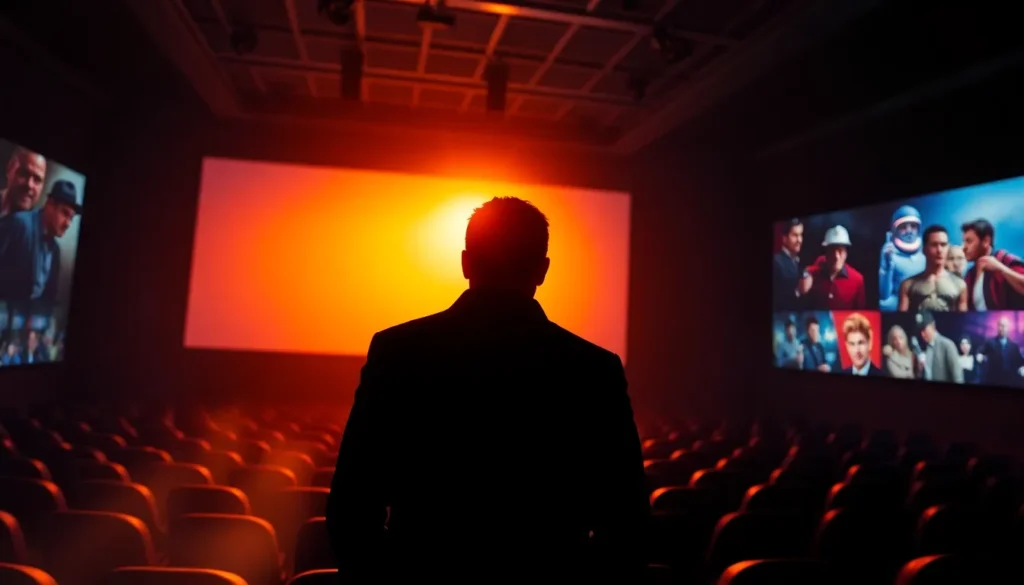Table of Contents
ToggleEvery movie buff knows that some moments transcend the screen, embedding themselves in pop culture like a catchy tune you can’t shake off. Legendary movie scenes have a way of making audiences laugh, cry, or even question their life choices—all while delivering unforgettable quotes. From epic battles to heartwarming revelations, these cinematic gems keep viewers coming back for more.
Imagine sitting with friends, quoting lines from a classic film, and suddenly feeling like you’re part of something bigger. These scenes are the lifeblood of cinema, showcasing the art of storytelling at its finest. They spark conversations and inspire countless memes, proving that a single moment can change how we see the world. So grab your popcorn and settle in as we dive into the most iconic movie scenes that left an indelible mark on film history.
Overview of Legendary Movie Scenes
Legendary movie scenes hold a pivotal role in cinema, marking significant moments that resonate with audiences. These scenes create lasting impressions through unique storytelling techniques and visual artistry. Iconic moments often emerge from films that blend strong narratives with compelling performances.
Take, for example, the famous “I am your father” revelation from Star Wars: The Empire Strikes Back. This scene transformed the understanding of characters and relationships in film. The emotional intensity delivered by the actors contributed to its status as a timeless moment.
Another significant scene comes from Casablanca, where Rick’s decision to let Ilsa go showcases themes of love and sacrifice. Such scenes elicit emotions and provoke thought, making them unforgettable to viewers. Engagingly crafted dialogues coupled with powerful performances amplify these moments, creating memorable quotes that audiences often reference.
Cinematic history shows that iconic scenes frequently lead to cultural phenomena, sparking discussions and memes across social media platforms. As audiences share their favorite film moments, they foster connections through shared experiences, illustrating the universal language of storytelling.
Collectively, these legendary scenes contribute to the narrative fabric of film and shape the cultural landscape. Each scene provides a glimpse into the human experience, reflecting emotions and provoking reflection. Examining these moments unveils the artistry behind their creation and the profound impact they have on cinema and society.
Iconic Scenes in Film History

Iconic movie scenes capture the essence of cinema, leaving lasting impressions that resonate universally. Their significance extends beyond the screen, influencing culture and memory.
The Impact of Cinematography
Cinematography plays a crucial role in creating iconic film moments. Visual techniques like lighting, framing, and camera movement enhance emotional engagement. For instance, the use of shadows in film noir heightens suspense, drawing viewers into the story. Classic scenes, such as the long take in “Birdman,” showcase how deliberate camera work can elevate narrative intensity. Each shot serves a purpose, whether it reveals character depth or sets the film’s tone. Film-makers utilize innovative angles to create memorable imagery, achieving artistic expression that complements the storyline.
Memorable Dialogue and Delivery
Memorable dialogue resonates long after the credits roll. Lines like “Here’s looking at you, kid” from “Casablanca” convey deep emotion through their delivery. Actors bring these words to life, making them iconic through timing and expression. Effective dialogue not only defines characters but also encapsulates pivotal moments. In “The Godfather,” Vito Corleone’s assertion of family creates a powerful narrative anchor. Powerful delivery transforms simple lines into cultural touchstones, prompting quotes and references across multiple platforms. Engaging dialogue establishes connections, making film scenes unforgettable.
Analysis of Specific Legendary Movie Scenes
Iconic movie scenes resonate with audiences and have become part of cultural conversations. Their ability to evoke emotions and spark dialogue showcases their significance in film lore.
The Opening Scene of “Star Wars”
The opening scene of Star Wars immediately transports viewers into a galaxy far, far away. A sense of urgency prevails as the iconic score plays while a massive Star Destroyer looms overhead. Viewers experience a mix of awe and anticipation, setting the stage for an epic saga. Iconic imagery intertwines with storytelling, creating a visual feast that captures attention. Through its innovative special effects and bold narrative, this scene solidifies Star Wars as a pioneering force in cinematic history.
The “I Am Your Father” Revelation in “The Empire Strikes Back”
Emotion bursts forth during the “I am your father” scene in The Empire Strikes Back. Darth Vader’s shocking revelation redefines Luke Skywalker’s character arc and the narrative trajectory of the series. Tension builds through dialogue and acting, leaving audiences in disbelief. This moment alters the perception of good and evil, adding depth to both characters. The powerful delivery by Vader becomes a memorable cultural touchpoint, echoing through film discussions for decades.
The Dance Scene in “Pulp Fiction”
The dance scene in Pulp Fiction captivates audiences with its stylish choreography and iconic soundtrack. Mia and Vincent’s movements create a fascinating blend of tension and chemistry. Through this scene, Quentin Tarantino showcases a unique storytelling approach that combines dialogue and character development. Various elements, including the choice of music, enhance its iconic status, solidifying it in pop culture. This memorable moment exemplifies the artistry behind combining cinematography with character interactions.
Cultural Significance of Legendary Movie Scenes
Legendary movie scenes shape cultural conversations and reflect societal values. These moments resonate with audiences, embedding themselves into collective memory. Iconic quotes and emotional connections lead to discussions that transcend the screen, often resulting in viral memes and references in everyday life.
Memorable scenes serve as touchpoints for shared experiences. They encapsulate pivotal feelings or ideas, inviting viewers to reflect on their own lives. For instance, the “I am your father” revelation evokes discussions about morality and identity, altering perceptions of familial loyalty and conflict. This depth extends beyond entertainment, fostering cultural dialogues that challenge and inspire.
Cinematography enhances the significance of these scenes. Unique techniques, such as lighting and camera angles, create immersive experiences that heighten emotional impact. The long take in “Birdman” exemplifies how technical innovation elevates narrative tension, immersing viewers in the character’s struggles. Audiences connect deeply with the visual artistry, making these moments unforgettable.
Dialogue plays a crucial role in defining legendary scenes. Lines like “Here’s looking at you, kid” and Vito Corleone’s assertions resonate due to their powerful delivery and context. Engaging dialogue encapsulates character essence and moment significance, reinforcing themes that resonate universally.
Cultural relevance is woven into iconic scenes’ fabric. The opening of “Star Wars,” for instance, revolutionized sci-fi with its stunning visuals and stirring score. This portrayal of heroism and adventure continues to inspire filmmakers and audiences alike. The dance scene in “Pulp Fiction” showcases character chemistry, reflecting styles that influence various media.
Legendary movie scenes are more than just moments on screen; they’re a reflection of human emotions and cultural narratives. These iconic instances not only entertain but also provoke thought and inspire conversations that transcend generations.
The artistry behind these scenes—whether through cinematography, dialogue, or performance—ensures their lasting impact on audiences. They become touchstones in pop culture, shaping how stories are told and experienced.
As filmmakers continue to draw inspiration from these timeless moments, their influence remains evident in both cinema and society. Legendary scenes will always hold a special place in the hearts of viewers, reminding them of the power of storytelling.







